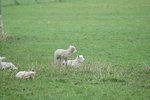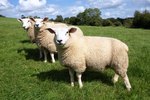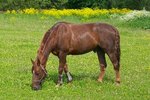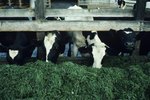Fescue foot in cattle results from consuming Neotyphodium coenophialum, an endophyte fungus found in tall, mature fescue grasses. The fungus constricts bovine blood vessels. Many herds do well in pastures with fescue and never experience a problem, but certain individuals are sensitive to the fungus. It appears that cattle with Brahman genes are more likely to develop fescue foot than other breeds. If a cow exhibits lameness within a few days of turnout in a field containing fescue, suspect fescue foot. It occurs most often in fall and winter.
Fescue Grass
Fescue grass has many positive attributes for grazing, making it a common choice worldwide for perennial pastures. In the United States, it's the predominant pasture grass in the central and eastern parts of the country. It's a tough, durable grass that stands up to insects, overgrazing and various grass pathogens.
Fescue Foot Symptoms
Symptoms of fescue foot include lameness in one or both of the rear hooves. The hocks may swell. Without treatment, the hooves and lower limbs develop gangrene, and the hoof literally comes off. Other signs include a rough coat, loss of muscle tone, back arching and necrosis of the ears or tail. The latter eventually causes the tail and ears to fall off.
Fescue Foot Treatment
The simplest treatment for fescue foot is moving affected animals from a field containing fescue into a fescue-free environment. Put a severely affected animal in a dry lot; feed her hay and perhaps some feed. The cow should improve within several days. A cow can certainly live without a tail, but should the hoof or leg become necrotic, euthanasia is the only option.
Fescue Foot Prevention
When seeding a new pasture or reseeding an old one, choose another type of grass or a fescue grass designed as "endophyte-free or friendly." Those considered "friendly" contain fescue that contains a type of endophytes found to be harmless to livestock.
References
Writer Bio
Jane Meggitt has been a writer for more than 20 years. In addition to reporting for a major newspaper chain, she has been published in "Horse News," "Suburban Classic," "Hoof Beats," "Equine Journal" and other publications. She has a Bachelor of Arts in English from New York University and an Associate of Arts from the American Academy of Dramatics Arts, New York City.





